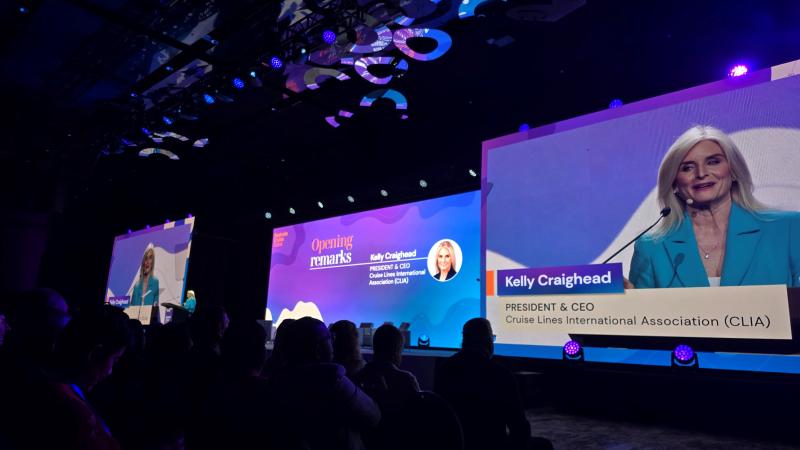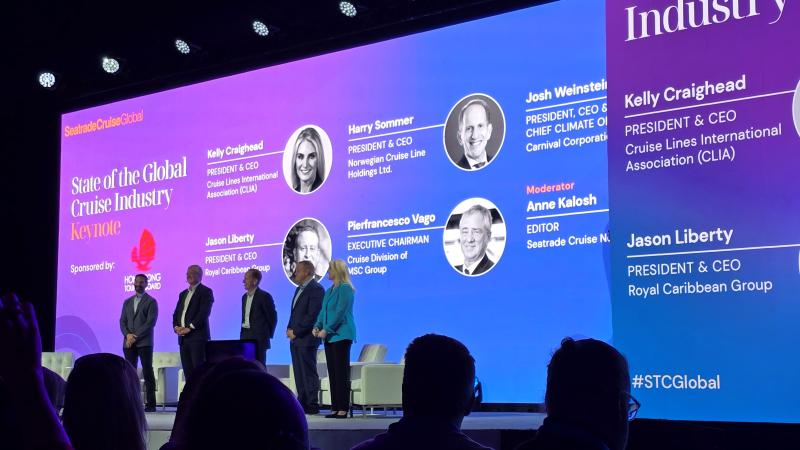As Seatrade Cruise Global kicked off Tuesday at the Miami Beach Convention Center in Florida, top leaders of the four largest cruise companies as well as Kelly Craighead, president and CEO of Cruise Lines International Association, provided their annual “State of the Industry” outlook. Speaking for two hours to thousands of attendees at the conference's first general session, they offered insight about cruising for 2024.
Among the key topics discussed? The top executives revealed firsthand “intel” about cruise trends, booking demand, the new-to-cruise market, cruise accessibility to port destinations, sustainability and more. Craighead also gave a separate, lead-in talk to the executive panel session. Travel Agent attended both sessions and here are our top takeaways for travel advisors and consumers.
Natural—Not Pent-Up—Demand
Growth in the number of people taking a cruise vacation is robust. In 2023, 31.7 million people cruised globally, according to CLIA’s Craighead. Growth on the horizon is projected to increase that number to 34.1 million cruise guests this year and 36.4 million in 2025.
When cruise lines restarted operations in 2021, consumer demand was described as “pent-up” causing a surge in bookings. However, in 2024, it’s different. Today, the global cruise industry is posting growth that Josh Weinstein, president, CEO and chief climate officer, Carnival Corporation, described as “natural demand.”
Simply put, "the concept of pent-up demand for cruising is gone,” Weinstein said. Record 2025 booking levels are no longer an indication of rebound, but rather indicate normalcy, he explained. Weinstein also said that the company’s 2024 outlook includes record yields, demand and passengers carried. Bookings for 2025 are also better than they were last year at this point for 2024. The other leaders are seeing similar positive booking trends, too.
Booking Growth Fuels Ship Orders
With soaring bookings, it’s not surprising that the biggest cruise companies have ordered new ships. On Monday, for example, Norwegian Cruise Line Holdings (NCLH) ordered eight new ships representing 25,000 new berths from Italy's Fincantieri shipayrd. They’ll be delivered between 2026 and 2028.
Recently, Royal Caribbean Group also ordered new ships including one new Oasis-class ship. Plus, Carnival Corporation ordered two new Excel-class ships for its Carnival Cruise Line brand. MSC Group, too, has been active in ordering new tonnage.
As it stands right now, Carnival has a total of four new ships on order while MSC Group has eight, Royal Caribbean Group has nine and NCLH has 13. Comparatively, Carnival Corporation’s order plan seems much more conservative, and that’s by design.
Weinstein told the Seatrade audience the plan is to take on some new ships but also to trim debt and add equity. For 2024, Carnival Corporation is giving itself a “lot of room to fortify ourselves as we did before the pause, to make sure we hit things on solid footing,” he noted.
New-to-Cruise Bookings Soar
When vacationers return from a positive cruise experience and tell their friends, relatives, neighbors and others about their experience, the result is simple: more bookings. In 2024, that positive ”word-of-mouth” is increasingly akin to a “call to action” for cruise lines.
Harry Sommer, president and CEO of NCLH, believes that the enthusiasm created by the “flywheel” of consumers who sail and then chat with people upon their return is strong. Those consumers who’ve sailed and have had a positive experience are considered “trusted sources” by those who’ve never cruised, he told the Seatrade audience. So, their comments, particularly on social media, are causing new-to-cruise guests to take the leap and book.
Craighead said that the perception still exists that cruising is all about shuffleboard and bingo. But at the same time, she explained that younger audiences are helping change the messaging regarding what cruising is all about—by discussing such elements as theatrical or culinary activities, for example. She agreed that social media carries much weight with younger consumers and CLIA is spending more time in that arena: "This is what is attracting people to cruise."
Cruising Is Managed Tourism
In discussing the value of cruising to global ports and destinations, Craighead also spoke about one big benefit of cruise tourism: "Cruise is managed tourism." This is because cruise lines know two years in advance what their requirements are and what they're planning for a destination. So, destinations have time to prepare, adjust and adapt as needed. In contrast, land-based tourism numbers—tracking who's going to show up and when—can be much less predictable.

The Net-Zero Path Is a Regulatory Minefield
The top industry leaders concur that strong eco-protection, sustainability and getting to net-zero emissions by 2050 is where their lines and the industry are heading. They’re on the same page. But across the globe, many regulators, government agencies, destinations and fuel suppliers all have work to do, they believe.
As a strong sustainability and eco-advocate, Pierfrancesco Vago, executive chairman, cruise division for MSC Group, expressed frustration that the European Union’s regulatory positioning has put Europe out of step with other regions/countries around the world and also made cruising from Europe more expensive.
Similarly, Sommer's view is that there are incredibly diverse regulations that the industry must adhere to, and, worse yet, many aren’t compatible with each other. From the regulatory side, "if we were to focus on the goal rather than mandating specific steps, we would be able to reach that goal much quicker,” said Sommer.
Right now, one of the biggest industry concerns environmentally is that there’s a lack of “available, scalable and affordable” alternative fuels, according to Jason Liberty, president and CEO for Royal Caribbean Group. “We need to make sure we have fuel sources that are green fuel sources, that allow us to be able to burn and get to a net-zero position.” In other words, to replace fossil fuels in powering ships, “we kind of need to know where we’re skating to,” he stressed.
While the lines are working toward that net-zero goal and waiting for new sustainable fuels, many are using LNG for propulsion as well as shore power to cut emissions in port. The latter allows ships to tap into a port’s electrical grid. As more ports add shore power capability, Liberty would like to see nuclear-generated electricity used to power ships while in port.
China Sourcing For Some, Not Others
Both Royal Caribbean Group via its Royal Caribbean International brand and MSC Group via MSC Cruises will source guests from China this year. “We see the bookings are strong,” said Vago. Getting visas is difficult for many in China, so cruising is the “low-hanging fruit” in attracting Chinese travelers. An ocean voyage is often an easier way to visit Japan, Korea or other parts of Asia.
One unique tidbit? For Chinese guests, “it’s not anymore the shopping cruise that it was before,” Vago added, a reference to Chinese tourists seeking shopping above all else in their vacation, something that happened much in the past. Yes, they still shop, but Vago said they’re also seeking what other travelers around the world are—spending time with family and friends and enjoying experiences.
For now, neither NCLH nor Carnival Corporation have immediate plans for China service. Of the four major cruise companies, NCLH has a bit smaller fleet across its brands, so it could be a few years before the company returns, explained Sommer. At one point, Carnival Corporation had planned to use Costa Cruises’ ships in China, but post-pandemic those vessels are now in service for Carnival Cruise Line.
Innovation Is Driving Bookings
Moderator Anne Kalosh, editor of Seatrade Cruise News, asked the four cruise company leaders and Craighead what types of innovation are driving bookings.
Not surprisingly, Liberty talked about the new Icon of the Seas, the world’s largest ship, and its attributes. He also explained that his brands are striving to offer more immersion in the destination experience because guest expectations have broadened. Vago also cited a razzle-dazzle new ship, MSC World America, arriving in 2025. In addition, digitalization is offering innovation and "AI will be a game-changer,” he said, noting that it can provide “a flawless experience for the customer in the terminal.”
Sommer talked about innovating by simply doing the little things that matter. For instance, the company found out an interesting tidbit about why guests were using the call center because they couldn't find something out online. It was this: “Is a curling iron going to work” on the ship? Now, he says, guests can simply type that question in a search bar and “there’s no more searching through 80 pages and we’re seeing a reduction of calls into the call center.”
Speaking to innovation, Weinstein cited many things happening pre-cruise to smooth the guest experience as well as on ships. But ultimately, he believes: "It’s about the person-to-person experience on the ships and in destinations that actually separates us from what’s done on land,” he said.
Craighead’s view of innovation? She says just look at the industry’s “diverse range of products.”
The Competition Isn’t a Fellow Cruise Line

All the leaders say their cruise brands aren't competing with each other, but rather land-based vacations. "We’re chasing to close that gap to land-based vacations,” said Liberty.
Overall, within the cruise industry for all major cruise brands, the new ships and products being introduced today are “so extraordinarily much better than what was delivered in 2015, 2016 and 2017," said Sommer. He mentioned a past example used at Seatrade, that 1.5 percent of the vacation industry represents cruising, while the other 98-plus percent comes from hotels or resorts. “That’s our competition,” he emphasizes.
In the luxury segment, Vago's group operates Explora Journeys. "My competition is not other luxury brands, it’s other types of land-based offerings," and he's seeing luxury cruise growth in Europe. He used the example of "the best real estate in Portofino, Italy" and how cruising can effectively compete and draw new guests. That's a luxury hotel and it's beautiful, he explained, "but you can’t see all of Portofino and you can’t see the sunset because there is a hill.” On an Explora Journeys voyage that calls at Portofino, though, “you can see Portofino and you can see the sunset," he said.
So, as all the lines move through 2024, what’s on the horizon? From Craighead’s view, it is a “very bright future.”
Related Stories
Princess Cruises, Brightline Partner for “Rail & Sail” Program
Holland America Line, Audible Partner for Virtual Book Club